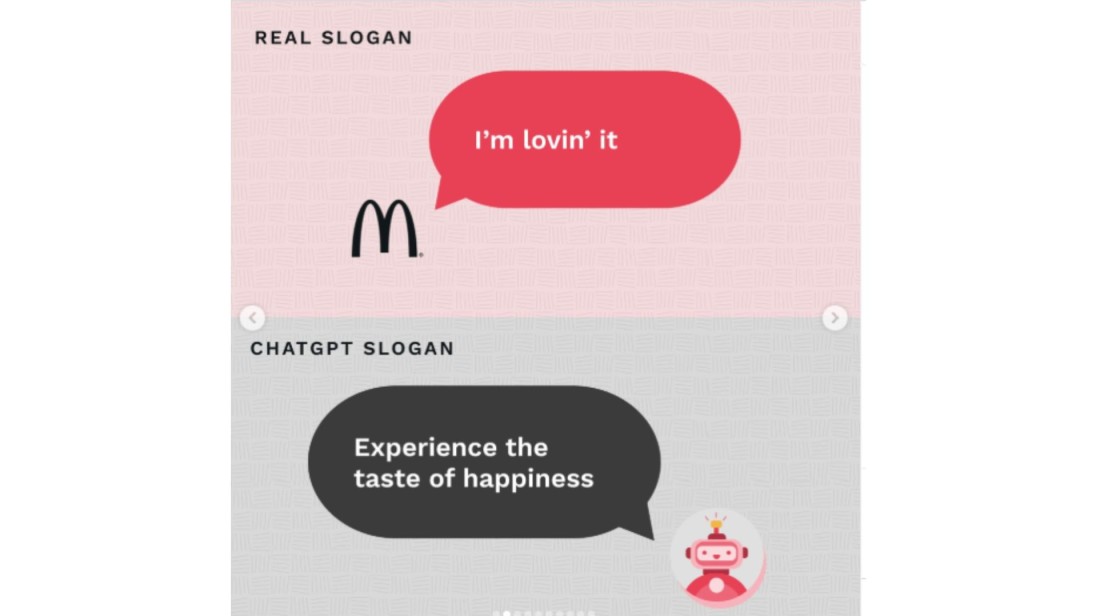ChatGPT helps you generate any written content within seconds. It has made content creation faster and more accessible for everyone.
In fact, an Authority Hacker survey found that almost 85.1% of digital marketers use ChatGPT for content creation, including product descriptions, blog content, and taglines.
But when it comes to writing powerful taglines that reflect your brand’s voice, ChatGPT is not enough.
Because taglines are not just short phrases. They represent your emotions associated with the brand. While ChatGPT can help you with different ideas, you have to humanize its taglines with your human touch before using them. So they sound more natural, expressive, and emotionally engaging.
In this article, I’ll show you what’s wrong with ChatGPT-generated taglines and how an AI humanizer can help you write taglines that truly connect with your audience.
Why should we humanize AI taglines generated by ChatGPT?
ChatGPT creates many taglines in an output, but the uniqueness that makes a tagline memorable is missing. ChatGPT follows predictable patterns in writing that create similar taglines every time you ask for it.
1. GPT’s taglines are often generic
Whenever you ask ChatGPT for taglines on your brand and niche, within seconds, it will create relevant and polished taglines. But they do not sound original.
For example, let’s ask ChatGPT to suggest taglines for my online fragrance store. The results are:
- Where Every Scent Tells a Story
- Luxury Fragrances, just a click away
- Indulge in timeless elegance.
- Unforgettable Scents. Unmatched elegance.
- Fall in Love with Every Whiff
- Smell Bold. Shop Smart

These are good, but they sound too generic. Like you have heard them before.
That’s because these taglines are not truly original, but inspired by taglines already present somewhere online.
Whether you are planning content for social media or SEO, your tagline should represent the unique identity of your brand. That can’t happen with recycled ideas.
2. AI outputs are often repetitive
One of the biggest issues with ChatGPT-generated taglines is repetition. If you ask the same question again or ask for more content, you will often get a variation of the same thing again.
Like it generates content from the same example over and over again. That’s because the content is created using the information present in online databases, not original thinking.
3. Its results lack natural flow
Even the smartest AI chat bots like ChatGPT often miss the natural tone. The taglines they generate are grammatically correct, but they can feel robotic, overly polished, or just unnatural.
For example:
- Shoes for every step you take
- Designed for comfort and built for style
- Step into quality with every pair
That’s because ChatGPT relies on rules and patterns, not instincts or emotions like us. And that’s why many marketers often use paraphrasers like wordchanger.net to improve the slogans they generate with AI.
4. Taglines are emotionless

Emotional appeal is a powerful force in marketing. It creates a connection with the target audience, builds trust, and encourages action.
But AI does not feel. Nor does it have any experience or emotions to reflect. That’s why the business taglines created by ChatGPT lack relevancy, urgency, or inspiration.
An American Author, Zig Ziglar, once said about this, “People don’t buy for logical reasons. They buy for emotional reasons.”
Emotional reasons or pain points create relevancy between our target audience and our tagline. Which helps our audience take action and improve our sales.
5. Flagged as AI by AI detectors
The patterns that AI uses to create content are easily detectable by AI detectors and the readers as well. Google prefers human content over AI-generated content. Plus, 52% of consumers feel AI content is less engaging.
So, if you're using these taglines for marketing, branding, or publishing, AI similarity can hurt your credibility.
It is always smart to detect AI-generated content in your taglines through an AI detector like the one at checker-plagiarism.com and be safe.
Then you have to improve the robotic tone and add a human touch, making the content feel natural and fresh.
The role of AI humanizer in creative copywriting
AI humanizers are AI tools too, but these are specially trained to detect and rewrite AI content in the best human way possible.
- They use NLP (natural language processing) and machine learning to understand the context of the passage and rewrite it with new sentence structures and vocabulary. This way, they keep the context but make the content new.
- Not only that, they are also capable of writing with emotions and creativity, improving the readability. Some of them even offer many different tones as well. So that you can match your taglines with your brand voice, especially the persuasive mode. It is very effective in rewriting marketing content.
- As these tools cannot write any content, marketers use generative AI tools like ChatGPT to create first drafts. Then they humanize AI-generated content with different AI humanizers online.
- One very significant thing that a humanizing AI text tool does is use the words that we humans normally use in our conversations. This creates an effect like the brand is directly talking to us. For example, “Shoes that don’t make you choose between style and comfort.”
Conclusion
ChatGPT is the most popular tool when it comes to generating taglines. That does not mean it writes ready-to-use marketing material like taglines.
It suggests different ways to come up with catchy lines, but it is your human eye that can determine what represents you and your brand the best.
So, the next time you create taglines with ChatGPT, don’t stop there. Humanize AI content with a reliable tool like humanizador.net, humanize-ai-text.net, or similar others to inject your creativity as well. Let your brand voice shine through with authenticity and emotion.








